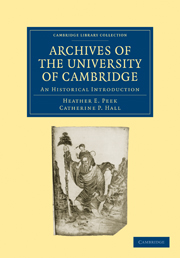Book contents
- Frontmatter
- Contents
- List of Plates
- Preface
- PART I
- PART II
- 4 The University and Colleges as Privileged Corporations
- 5 Records of University Administration
- 6 Records of Matriculation and Degrees
- 7 Financial Records of the University
- 8 Endowments of the University
- 9 University Officers and their Records
- 10 Records of the University Courts
- 11 Records of University Jurisdiction in the Town of Cambridge
- 12 The Relations between the Crown and the University
- 13 Other University Institutions and their Records
- APPENDICES
- Index
- Index to Muniments of Title in Appendix B
- Plate section
12 - The Relations between the Crown and the University
Published online by Cambridge University Press: 07 September 2010
- Frontmatter
- Contents
- List of Plates
- Preface
- PART I
- PART II
- 4 The University and Colleges as Privileged Corporations
- 5 Records of University Administration
- 6 Records of Matriculation and Degrees
- 7 Financial Records of the University
- 8 Endowments of the University
- 9 University Officers and their Records
- 10 Records of the University Courts
- 11 Records of University Jurisdiction in the Town of Cambridge
- 12 The Relations between the Crown and the University
- 13 Other University Institutions and their Records
- APPENDICES
- Index
- Index to Muniments of Title in Appendix B
- Plate section
Summary
Although the crown was the patron and protector of the university from the earliest times, as the series of royal charters shows, it was not until the sixteenth century that the crown and its chief ministers began to be very closely concerned with the details of policy and administration of the university. From the Act of Supremacy of 1534, the Tudor sovereigns, uniting the functions of temporal and ecclesiastical head, were able to use their prerogative and dispensing powers to exercise a greater degree of direct control over the activities of the university than had hitherto been the case. The Royal Injunctions of 1535 (of which no contemporary copy remains in the archives) and the Elizabethan statutes of 1570, compiled by Whitgift and laid down by the crown for the university, are the most striking documents which bear witness to the new attitude. The former deals primarily with the content of university education and the latter, in addition to this, with the machinery of university administration. By the Act for the Incorporation of the Universities of 1571, the privileged, autonomous, corporate status of the universities both of Oxford and Cambridge was made dependent solely upon the crown (and the crown and parliament) instead of, as in former times, upon a heterogeneous collection of privileges, some of royal, some of ecclesiastical authority.
The concern of the sovereign that the ancient seats of learning should be centres of sound religion and morals, manners, and instruction is shown, particularly in the reigns of Elizabeth I and James I, by frequent personal letters, inquiries, and returns, directions and exhortations, sent to the vice-chancellor or to the university as a whole.
- Type
- Chapter
- Information
- Archives of the University of CambridgeAn Historical Introduction, pp. 65 - 67Publisher: Cambridge University PressPrint publication year: 1963First published in: 1962



